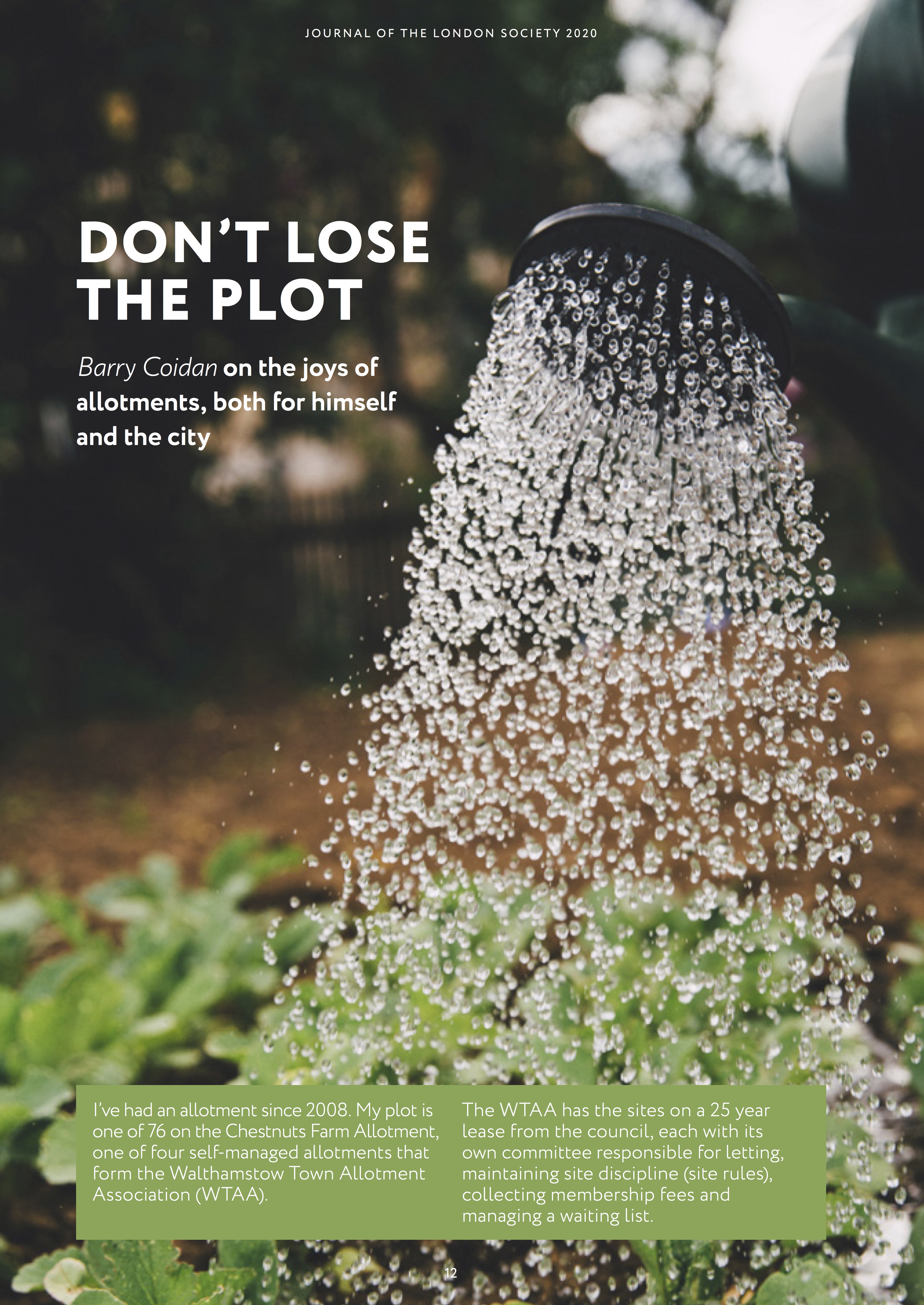Post
JOURNAL 2020 | Don't Lose the Plot
26 Mar 2020
Don’t lose the plot
Barry Coidan on the joys of allotments, both for himself and the city
Article taken from the 2020 edition of the Journal of The London Society. Find out how to get a print copy of the Journal here - we are still mailing them out even during the lockdown.
I’ve had an allotment since 2008. My plot is one of 76 on the Chestnuts Farm Allotment, one of four self-managed allotments that form the Walthamstow Town Allotment Association (WTAA).
The WTAA has the sites on a 25 year lease from the council, each with its own committee responsible for letting, maintaining site discipline (site rules), collecting membership fees and managing a waiting list. Waiting lists fluctuate. At the moment we have 16 applicants on ours and to qualify you have to live in Waltham Forest. Most people live in walking distance.
It takes some effort to keep your plot in good order. Levels of commitment vary but we set minimum standards. A plot must have 80 per cent under cultivation, and should be weed-free and tidy. This can pose problems since some people think allotments can look after themselves; they most certainly can’t!
Take 2019: a mild winter so bugs weren’t killed and weeds didn’t die. The first sign of warmth and moisture and you’re there weeding the hell out of your plot. You’ve got to get your seeds started, in your on-site greenhouse or shed. You’ve loaded the soil with plenty of organic manure from the local stables – delivered by the lorry load, giving rise to complaints from the neighbours in surrounding houses. You won’t use weed killer, grass killer, bug killer, tree killer too liberally and you’ll ensure that all the cut grass is well composted along with weeds and other nasties. All this before the summer kicks in. Periods of near desert conditions, with watering required every day, are followed by antediluvian floods and grass on the paths as high as an elephant's eye. But it was also my most successful year to date. I’ve had wonderful potatoes, onions that are off the scale, lashings of rhubarb, French beans par excellence, and tomatoes that will keep me in passata until 2021.
Allotments offer far more than fresh food. The London Assembly report A Lot to Lose: London's disappearing allotments, published back in 2006, cited the various benefits of allotments: social, health, environmental and financial along with the benefit to the community and diversity. However, it also found that allotment sites within all 33 councils fell from 769 in 1996 to 737 ten years later , or from 22,319 plots to 20,786 for the 20 councils for whom complete data was available. The largest number of sites were in the outer London boroughs of Brent, Bromley and Ealing, while only the Corporation of London, Kensington & Chelsea, and Westminster had none. Meanwhile waiting lists were on the rise, helped by the popularity of TV gardening programmes. Today that’s been joined by health concerns and the carbon free agenda.
In a London where land values have rocketed, allotments are also eye watering opportunities for developers and, more worryingly, cash cows for cash-strapped local authorities. Ask any allotmenteer and you’ll hear of fears or rumours of councils planning to sell off sites. Luckily legislation makes it arduous for councils to get their hands on sites, but with pressure on available land and the need to build homes, especially in London, we lovers of allotments and open spaces need to be ever vigilant.
The story is one of flux. Allotments have been around for ages – ours since 1919. They provide a lung for cities, peace and quiet for many, a community and a place where wildlife can go about its business more or less unmolested. But they are under threat through lack of interest, ignorance and commercial imperative. It’ll be a hard fight to keep this unique heritage alive.
Barry Coidan is a former civil servant and secretary of the Allotment Society.
For information on how to get an allotment, contact the National Allotment Society nsalg.org.uk
